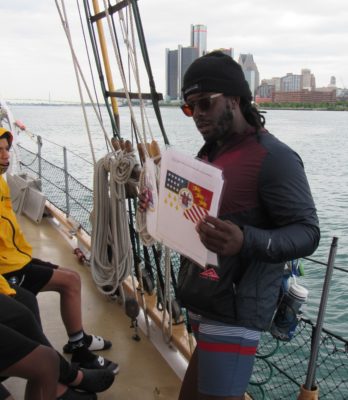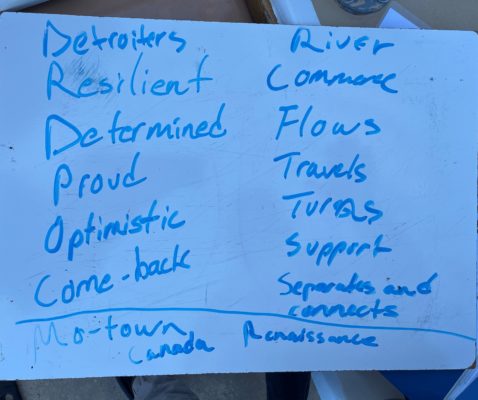When asked to describe Detroit, a common first thought is Henry Ford and the mass production of the automobile. To many, Detroit has the perception of a once booming trade hub that has been in consistent decline as manufacturing jobs moved outside the United States. While there is some truth to this, Detroit has a long history of prosperity and heartbreak, with much of its stories tied to the Detroit River that separates the city from Canada.
The Detroit River plays an important role in the Great Lakes ecosystem. Lake Huron is connected to Lake St. Clair which then becomes the Detroit River flowing into Lake Erie. How we treat our Great Lakes anywhere within the watershed impacts the ecosystem’s overall health. Giving ownership to program participants of their river is a key part of our teaching. The river needs its own set of stewards to stand up for the protection and health of the water.
The river needs its own set of stewards to stand up for the protection and health of the water.

The current Detroit Flag features the official seal in the center. The words on the seal in the middle translate to “we hope for better things; it shall arise from the ashes.” The corners depict stars and stripes representing the United States, five gold fleurs-de-lis representing France, and three gold lions representing England. All of these imperialist powers have been the dominant force of settlement in the city at some point, but the flag leaves out two notable groups of people. Black and Indigenous Americans, by design. This omission is a part of a larger happening throughout American history of minimizing the impacts of Indigenous settlements and the history of Black labor. There is no rebuilding of the city without black and indigenous people. There is no representation of the Ojibwe, Ottawa, Potawatomi, and Wyandot tribes that settled in Detroit. There is no representation of the once enslaved people who used the Detroit River as a part of the underground railroad to seek freedom on the other side in current-day Winsdor, Ontario.
One of our summer interns, Marquise Griffin, has spent part of this summer developing his own station to teach aboard the schooner Inland Seas during our Detroit programs. Marquise, originally from St. Louis, Missouri, is currently a Ph.D. student at the University of Michigan whose Detroit River Story Lab is co-sponsoring his internship and ISEA’s Detroit River programming. Marquise is passionate about creating hands-on literature programs that tie into nature. He is examining the similarities between St. Louis and Detroit as river cities. The station challenges learners to think about “settlement, stewardship, and sense of place” as they reflect on the river’s history. His station first asks participants to describe what adjectives come to mind when they hear “Detroit” and “Detroiter.” These participants come from greater Detroit-area middle and high schools along with local colleges. Common themes throughout our programs so far have been resilient, proud, determined, optimistic, welcoming, and under-appreciated.

Next, Marquise asks participants to describe adjectives when hearing the word “river.” For some, the history of the river has been minimized and pushed away over time. Rivers are described by participants as supporters of travel, movement, good, people, and life. However, the connection to the city itself is missing despite the deep history behind the Detroit River. For many black communities in Detroit, their history of the river is not shared with them. Many students haven’t seen the city’s official flag before despite living there. He uses this to examine the absence of rivers in the symbols of Detroit. This is important because the story of Detroit is heavily influenced by the river from the fur trade to the underground railroad.
Marquise then shares symbols of two other river cities, St. Louis and Milwaukee, and how they include the river. While the flags of these cities do involve their rivers, the symbolism still heavily involves imperialist powers and there still is no symbolism to empower the people who have built the city into what it is.
The overarching question for this station is, “How would you redesign the City of Detroit flag?” Being an open-ended question, there are numerous answers. However, station participants are able to recognize the lack of awareness and appreciation towards black and indigenous people and suggest symbolism to represent these groups along with the inclusion of the Detroit River and all her history.
This blog was written by Caleb Ameel, 2022 Marketing and Communications Summer Intern for Inland Seas Education Association. Caleb is a recent graduate of Grand Valley State University with a B.B.A. in Marketing. In his off time, he enjoys kayaking, playing golf, and exploring the outdoors. Growing up in Traverse City, connection with the Great Lakes has always been important to him.